27 Customizable Meeting Follow-up Letter Templates: Enhance Communication and Drive Success
Welcome to our website dedicated to Meeting Follow-up Letters! We understand the importance of effective communication and seamless collaboration in today’s fast-paced business world. Our platform aims to provide you with valuable insights, tips, and resources on how to leverage follow-up letters to enhance your post-meeting interactions. Whether you’re seeking guidance on crafting impactful letters, looking for customizable templates, or exploring the benefits of utilizing these letters, you’ve come to the right place. Join us on this journey to streamline your follow-up processes, strengthen professional relationships, and drive successful outcomes. Let’s dive into the world of Meeting Follow-up Letters together and unlock the potential of effective post-meeting communication.
Benefits of Using Meeting Follow-up Letters
- Enhances communication: Follow-up letters provide a written record of the meeting discussions, decisions, and action items, ensuring that all participants have a clear understanding of what was discussed and agreed upon.
- Promotes accountability: By documenting tasks, responsibilities, and deadlines, follow-up letters help hold individuals accountable for their assigned actions and ensure timely progress.
- Reinforces shared understanding: Summarizing the key points and conclusions of the meeting in a follow-up letter helps align all participants and reinforces a shared understanding of the discussed topics.
- Facilitates task management: Follow-up letters outline specific action items and next steps, helping participants prioritize and manage their tasks effectively.
- Supports follow-up actions: Requesting additional information, seeking clarifications, or scheduling follow-up meetings through the letter ensures that necessary actions are taken to address any unresolved issues.
- Demonstrates professionalism: Sending a well-crafted follow-up letter showcases professionalism and demonstrates your commitment to effective communication and follow-through.
- Builds trust and credibility: Providing timely follow-up shows respect for participants’ time and attention, which helps build trust and credibility among team members or stakeholders.
- Improves meeting outcomes: By capturing and summarizing the meeting discussions and decisions, follow-up letters contribute to better outcomes by keeping everyone informed and focused on achieving the meeting objectives.
#1: Thank you for the meeting:
A brief letter expressing gratitude for the opportunity to meet and discuss matters of importance. A “Thank you for the meeting” letter is a brief expression of gratitude sent to participants after a meeting to acknowledge their time and contribution. It demonstrates professionalism and courtesy while building rapport with the recipients. Such a letter helps foster positive relationships, encourages future collaboration, and shows respect for the attendees’ valuable time and input. Overall, it reinforces the importance of mutual respect and gratitude in professional interactions.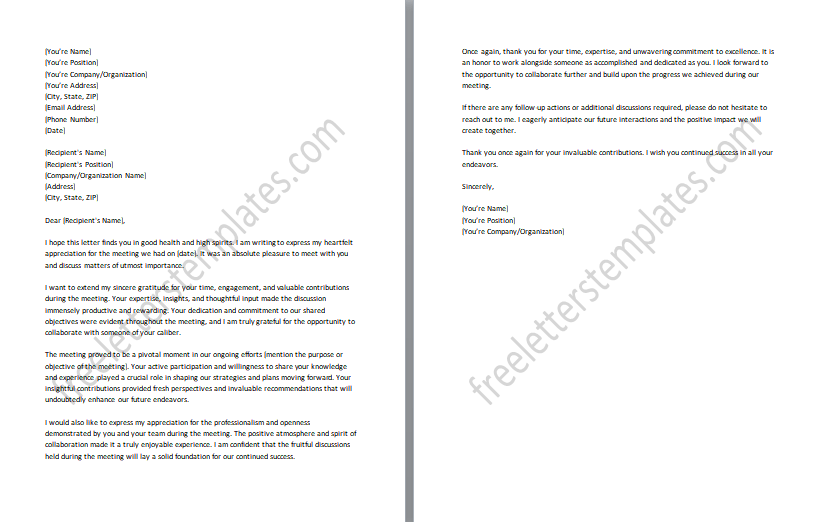
#2: Recap of meeting highlights:
A letter summarizing the key points, decisions, and discussions from the meeting for the recipients’ reference. A “Recap of meeting highlights” letter serves as a concise summary of the key points, decisions, and discussions from a meeting. By summarizing the main takeaways, it ensures that all participants have a shared understanding of the meeting’s outcomes. This type of letter is particularly useful for documenting important information, serving as a reference for future actions, and ensuring alignment among team members. It enables participants to reflect on the meeting, reinforces accountability, and facilitates effective communication and follow-up.
#3: Action items and next steps:
An email outlining the specific tasks, responsibilities, and deadlines assigned during the meeting. An “Action items and next steps” email is a valuable tool for outlining the specific tasks, responsibilities, and deadlines assigned during a meeting. The purpose of this email is to provide clear instructions to all participants regarding their assigned actions, ensuring everyone is aware of their responsibilities and the associated timelines. By summarizing the action items and next steps in a concise and organized manner, this email serves as a reference point for individuals to stay focused and accountable. It helps maintain momentum, promotes effective task management, and facilitates coordination among team members.
#4: Follow-up on pending decisions:
A letter addressing any unresolved or pending decisions from the meeting and seeking further input or clarification. A “Follow-up on pending decisions” letter is a communication tool used to address any unresolved or pending decisions from a meeting. This letter serves as a proactive approach to maintaining progress and accountability by addressing outstanding decisions promptly. It demonstrates the commitment to follow through on the decision-making process and seeks to gather any additional information or insights required for finalizing those pending decisions. By sending this letter, it fosters open communication, encourages collaboration, and ensures that all decisions made during the meeting are thoroughly addressed and resolved.
#5: Request for additional information or materials discussed in the meeting:
A letter asking for any relevant documents, data, or resources mentioned during the meeting. A “Request for additional information or materials discussed in the meeting” letter is a formal correspondence seeking any relevant documents, data, or resources that were mentioned or referenced during the meeting. By making this request, it demonstrates the importance of accurate and complete information in decision-making and project execution. This letter serves as a means to gather any missing or supplementary materials, ensuring that everyone is on the same page and has the required resources to fulfill their tasks. It promotes transparency, collaboration, and the efficient flow of information among team members, ultimately contributing to the success of the project or initiative discussed in the meeting.
#6: Confirmation of agreed-upon deadlines:
A letter confirming the deadlines set during the meeting and ensuring everyone is on the same page. A “Confirmation of agreed-upon deadlines” letter is a formal communication sent to all participants of a meeting to reiterate and confirm the deadlines that were set during the meeting. By providing a summary of the agreed-upon deadlines, this letter eliminates any ambiguity or potential miscommunication regarding timelines. It serves as a reference point for individuals to prioritize their work and plan accordingly. This confirmation letter promotes accountability, fosters effective time management, and contributes to the overall success and timely completion of the project or initiative discussed in the meeting.
#7: Follow-up on assigned tasks or responsibilities:
A letter checking in on the progress of tasks assigned during the meeting and offering assistance if needed. A “Follow-up on assigned tasks or responsibilities” letter is a proactive correspondence that checks in on the progress of tasks assigned during a meeting and offers assistance if needed. The purpose of this letter is to ensure that the assigned tasks are being actively worked upon and to provide support or guidance where necessary. By reaching out to the individuals responsible for specific tasks, this letter encourages accountability, monitors progress, and addresses any potential challenges or roadblocks early on. It demonstrates a commitment to the successful completion of the project or initiative discussed in the meeting and reinforces a culture of collaboration and support within the team.
#8: Request for feedback on meeting outcomes:
A letter soliciting feedback from participants to evaluate the effectiveness of the meeting and identify areas for improvement. A “Request for feedback on meeting outcomes” letter is a formal communication seeking feedback from participants to assess the effectiveness of the meeting and identify areas for improvement. The purpose of this letter is to gather valuable insights and perspectives from attendees to enhance future meetings. This letter serves as a means to gather constructive criticism, identify strengths and weaknesses, and make necessary adjustments to optimize future meetings and achieve better outcomes.
#9: Request for clarification on unresolved issues:
A letter seeking clarification or further information regarding any unresolved issues or questions from the meeting. A “Request for clarification on unresolved issues” letter is a formal correspondence seeking additional information or clarification on any unresolved issues or questions from a meeting. Seeking clarification promotes clear communication, prevents misunderstandings, and facilitates effective decision-making. This letter serves as a proactive approach to resolving any lingering issues and ensures that participants have a complete understanding of the matters discussed in the meeting. It fosters transparency, collaboration, and a shared commitment to finding solutions.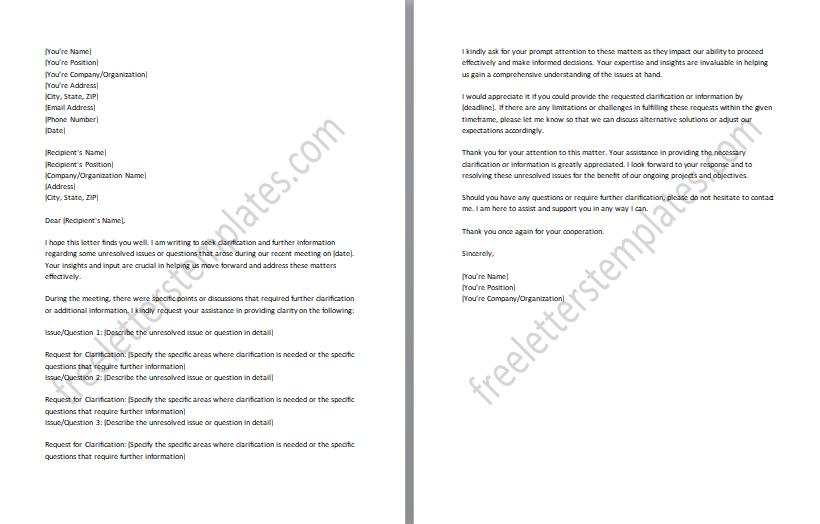
#10: Appreciation for attendees’ contributions:
A letter acknowledging and expressing appreciation for the valuable contributions made by participants during the meeting. An “Appreciation for attendees’ contributions” letter is a formal expression of gratitude sent to participants to acknowledge and appreciate their valuable contributions during a meeting. Expressing appreciation fosters a positive and collaborative environment, strengthens professional relationships, and motivates participants to continue their active involvement. This letter serves as a sincere gesture to show gratitude for the valuable contributions that have enriched the meeting and demonstrates the value placed on each individual’s insights and contributions.
#11: Follow-up on meeting minutes or notes:
A letter providing a draft or final version of the meeting minutes or notes for participants’ review and approval. A “Follow-up on meeting minutes or notes” letter is a formal communication providing participants with a draft or final version of the meeting minutes or notes for their review and approval. The purpose of this letter is to ensure accurate documentation of the meeting proceedings and to seek participants’ input to confirm the accuracy and completeness of the minutes or notes. By sharing the document, it allows participants to review and provide any necessary corrections or additions, ensuring a comprehensive and reliable record of the meeting. This letter promotes transparency, accountability, and effective communication among all stakeholders involved.
#12: A reminder of upcoming meetings or follow-up sessions:
A letter reminding participants about future meetings or follow-up sessions related to the topics discussed. A “Reminder of upcoming meetings or follow-up sessions” letter serves as a gentle reminder to participants about future meetings or follow-up sessions related to the topics discussed. By sending this reminder, it helps to maintain attendance, encourage preparedness, and promote active engagement in ongoing discussions or follow-up actions. This letter serves as a helpful tool to keep participants informed, organized, and aligned, contributing to the overall success and continuity of the project or initiative.
#13: Summary of meeting discussions and conclusions:
A letter summarizing the key discussions, decisions, and conclusions reached during the meeting for wider dissemination. A “Summary of meeting discussions and conclusions” letter serves the purpose of providing a comprehensive overview of the key discussions, decisions, and conclusions reached during a meeting. The letter is intended for wider dissemination, ensuring that stakeholders who were not present at the meeting are informed about the outcomes. By summarizing the main points, this letter enables broader understanding, alignment, and engagement among the relevant individuals or teams. It serves as a reference document, facilitating effective communication, and ensuring that the decisions and conclusions from the meeting are effectively communicated and acted upon by all relevant parties.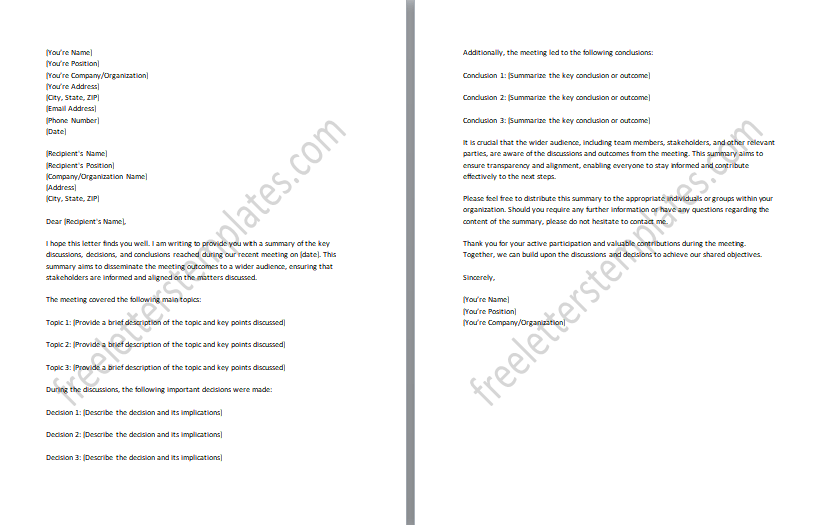
#14: Follow-up on specific action points assigned to individuals:
A letter specifically addressing individuals assigned with action points, reminding them of their tasks and timelines. A “Follow-up on specific action points assigned to individuals” letter is a friendly and proactive communication that specifically addresses individuals who have been assigned action points during a meeting. The purpose of this letter is to kindly remind them of their assigned tasks and associated timelines. Reaching out in a personable tone emphasizes the importance of their contribution and ensures they stay on track with their responsibilities. This letter serves as a supportive reminder, offering any necessary clarifications or resources they may need to accomplish their tasks. It fosters accountability, collaboration, and a sense of shared commitment toward achieving the desired outcomes of the meeting.
#15: Request for further meetings or discussions on specific topics:
A letter proposing future meetings or discussions to delve deeper into specific topics discussed during the previous meeting. A “Request for further meetings or discussions on specific topics” letter is a proactive communication that proposes future meetings or discussions to explore specific topics in greater detail, building upon the discussions from the previous meeting. This letter catalyzes ongoing dialogue, enabling participants to delve deeper into relevant subjects, gather additional insights, and make informed decisions. It promotes a culture of continuous learning, innovation, and effective decision-making within the organization or group.
#16: Update on progress made since the meeting:
A letter providing an update on the progress made on tasks or projects discussed during the meeting. An “Update on progress made since the meeting” letter is a communication that provides stakeholders with an overview of the progress made on tasks or projects discussed during a previous meeting. The purpose of this letter is to keep all parties informed about the advancements, achievements, and challenges encountered since the meeting. Sharing the update ensures transparency, and accountability, and fosters effective communication among team members or stakeholders. This letter serves as a tool to align expectations, address any potential concerns, and maintain a shared understanding of the project’s status.
#17: Expression of gratitude for the opportunity to meet:
This is a brief letter expressing gratitude for the chance to meet and engage in productive discussions. An “Expression of gratitude for the opportunity to meet” letter is a short and heartfelt communication that expresses appreciation for the chance to meet and engage in productive discussions. Expressing gratitude strengthens professional relationships, fosters a positive atmosphere, and acknowledges the value of collaboration. This letter serves as a courteous gesture to show appreciation for the meaningful interactions and outcomes achieved during the meeting. It leaves a positive impression and builds rapport with the recipients.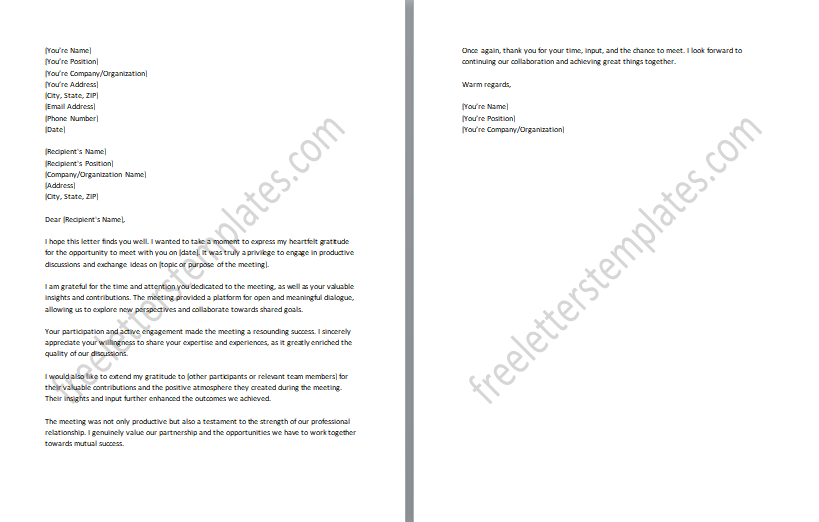
#18: Response to requests or queries raised during the meeting:
A letter addressing any requests or queries raised by participants during the meeting and providing necessary information or solutions. A “Response to requests or queries raised during the meeting” letter is a formal communication that addresses any requests or queries raised by participants during the meeting and provides the necessary information or solutions. By providing the requested information or offering viable solutions, it demonstrates attentiveness, professionalism, and a commitment to meeting the needs of the participants. This letter serves as a means to provide clarity, resolve any uncertainties, and foster effective communication, ensuring that participants have the necessary information to move forward with their tasks or make informed decisions.
#19: Confirmation of changes or updates to existing plans or projects:
A letter confirming any changes or updates made to existing plans or projects as a result of the meeting. When it comes to confirming changes or updates to existing plans or projects discussed in a meeting, a “Confirmation of changes or updates” letter plays a crucial role. This letter ensures that everyone involved is on the same page regarding any modifications made. Providing clear and concise information, helps stakeholders understand the revised direction, scope, or timeline of the plans or projects. This letter acts as a reliable reference point, keeping everyone accountable and facilitating effective implementation of the updated plans or projects. Its purpose is to maintain clarity, promote collaboration, and ensure successful outcomes.
#20: Acknowledgment of challenges or concerns raised during the meeting:
A letter acknowledging any challenges or concerns raised during the meeting and outlining potential solutions or actions. Addressing challenges or concerns raised during a meeting, an “Acknowledgment of challenges or concerns” letter takes a proactive approach to acknowledge the issues brought forth. This letter demonstrates attentiveness to participants’ feedback, highlighting their concerns and the importance of their perspectives. It aims to foster a supportive and collaborative environment by outlining potential solutions or actions to address the challenges identified. This letter serves as a stepping stone toward finding effective resolutions and strengthening relationships among the participants.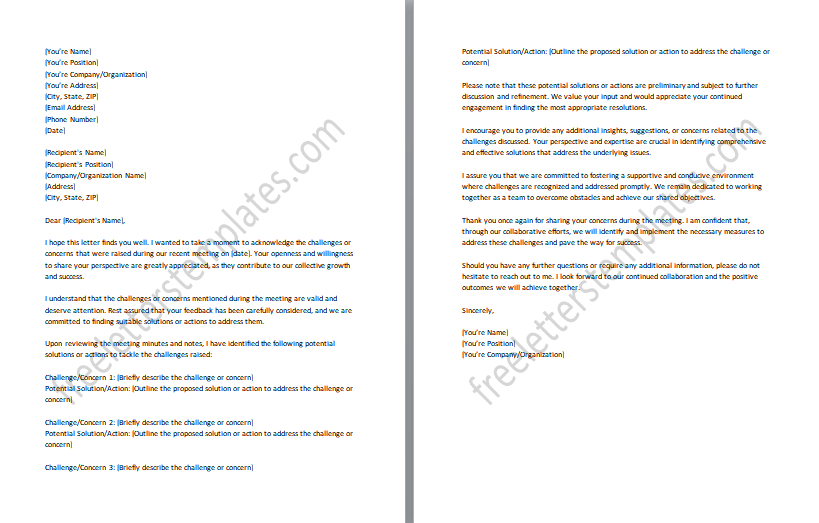
#21: Offer of assistance or support for tasks discussed in the meeting:
A letter offering assistance, guidance, or support for tasks or initiatives discussed in the meeting. In the spirit of collaboration and teamwork, an “Offer of assistance or support” letter extends a helping hand, guidance, or support for tasks or initiatives discussed during the meeting. This letter reflects a genuine commitment to the success of the shared goals and projects. By reaching out, it demonstrates a willingness to contribute expertise, resources, or any other form of assistance required. It emphasizes the value of collective effort and underscores the importance of working together towards a common objective.
#22: Request for additional input or suggestions related to discussed matters:
A letter seeking further input or suggestions from participants on matters discussed during the meeting. When seeking further input or suggestions from participants on matters discussed during a meeting, a “Request for additional input or suggestions” letter invites valuable contributions and insights. This letter demonstrates a genuine interest in gathering diverse perspectives to enhance decision-making and problem-solving processes. It catalyzes innovative thinking and reinforces the notion that everyone’s input is valued and essential for achieving successful outcomes.
#23: Follow-up on agreed-upon strategies or initiatives:
A letter following up on the implementation and progress of agreed-upon strategies or initiatives discussed during the meeting. When it comes to following up on agreed-upon strategies or initiatives discussed in a meeting, a “Follow-up on agreed-upon strategies or initiatives” letter serves as a valuable tool. This letter ensures that the implementation of the agreed-upon strategies or initiatives is on track and progressing as planned. Providing updates and monitoring progress, keeps stakeholders informed and engaged in the process. This letter fosters accountability, collaboration, and a sense of shared responsibility for the success of the strategies or initiatives.
#24: Invitation to provide further input or feedback on meeting outcomes:
A letter inviting participants to provide additional input or feedback on the outcomes of the meeting or specific topics discussed. When seeking to gather additional input or feedback on the outcomes of a meeting or specific topics discussed, an “Invitation to provide further input or feedback” letter creates an inclusive and collaborative environment. It emphasizes the value placed on their insights and demonstrates a commitment to continuous improvement. By inviting further input or feedback, this letter aims to gather diverse viewpoints, uncover new ideas, and ensure that decisions and actions are well-informed and reflective of the collective wisdom of the participants. It promotes engagement, fosters open communication, and reinforces a culture of ongoing learning and growth.
#25: Follow-up on outstanding questions or issues that require resolution:
A letter addressing any outstanding questions or issues that need resolution after the meeting. When addressing outstanding questions or issues that require resolution after a meeting, a “Follow-up on outstanding questions or issues” letter ensures that no loose ends remain. This letter specifically addresses unresolved matters and seeks to provide clarity and resolution. Acknowledging the importance of addressing these outstanding issues, demonstrates a commitment to thoroughness and effectiveness in decision-making. It aims to ensure that all concerns are properly addressed, enabling progress and fostering a sense of closure.
#26: Invitation to attend follow-up meetings or events:
A letter inviting participants to attend follow-up meetings or events related to the matters discussed during the initial meeting. When inviting participants to attend follow-up meetings or events related to the matters discussed in the initial meeting, an “Invitation to attend follow-up meetings or events” letter extends a warm and inclusive invitation. This letter serves as a reminder of the ongoing commitment to the discussed topics and the importance of continued collaboration. It outlines the purpose, date, time, and location of the follow-up meeting or event, emphasizing the relevance and benefits of participation. It conveys a sense of value placed on participants’ contributions and reinforces a culture of teamwork and ongoing dialogue.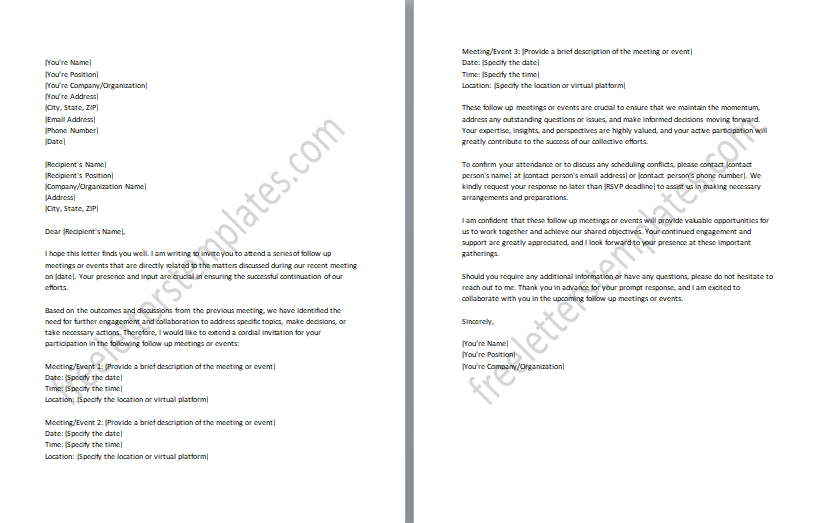
#27: Closing remarks and appreciation for attendee’s time and attention:
A letter providing closing remarks, expressing appreciation for participants’ time and attention, and emphasizing the importance of their contributions. When wrapping up a meeting and expressing gratitude for participants’ time and attention, a “Closing remarks and appreciation” letter serves as a final touch of appreciation and recognition. This letter acknowledges the valuable contributions made by attendees, emphasizing the significance of their input and ideas. By highlighting the importance of their contributions, this letter encourages continued collaboration and reinforces a sense of partnership. It serves as a reminder that their involvement and insights are integral to the success of the discussed matters. Overall, this letter aims to leave a positive and appreciative impression on the participants, fostering goodwill and building strong professional relationships.
Tips for Customizing Follow-up Letters
- Personalize the letter: Address the recipient by name and tailor the content to reflect the specific discussions and decisions made during the meeting.
- Include relevant details: Recap key points, decisions, and action items discussed during the meeting to ensure clarity and provide a comprehensive overview.
- Be concise and organized: Use clear and concise language to convey information effectively. Logically organize the letter, using headings or bullet points to highlight important details.
- Use a professional tone: Maintain a professional and respectful tone throughout the letter. Avoid jargon or complex language that may confuse the reader.
- Clarify expectations: Clearly state deadlines, responsibilities, and any other relevant expectations to ensure everyone is on the same page.
- Offer assistance and support: Show your willingness to assist or provide support if needed, emphasizing a collaborative approach and fostering open communication.
- Follow formatting guidelines: Use an appropriate letter format, including a professional salutation and closing. Pay attention to spelling, grammar, and punctuation to maintain a polished appearance.
- Proofread before sending: Take the time to review and proofread the letter for any errors or inconsistencies before sending it to ensure a professional and error-free document.
- Follow up if necessary: If you don’t receive a response or need further clarification, don’t hesitate to follow up with a polite reminder or request for feedback.
Harnessing the Power of Follow-up Letters
In conclusion, meeting follow-up letters serve as valuable tools for enhancing communication, ensuring clarity, and maintaining accountability in the post-meeting phase. By summarizing key discussions, documenting decisions, and outlining action items, these letters provide a tangible record of important information and facilitate efficient follow-up processes. Customizing these letters based on the specific needs of each meeting and recipient further enhances their effectiveness. Whether it’s expressing gratitude, seeking clarification, or providing updates, follow-up letters play a crucial role in strengthening professional relationships and driving successful outcomes. Incorporating these best practices and tips will help you craft impactful and personalized follow-up letters that yield positive results and contribute to your overall communication strategy.